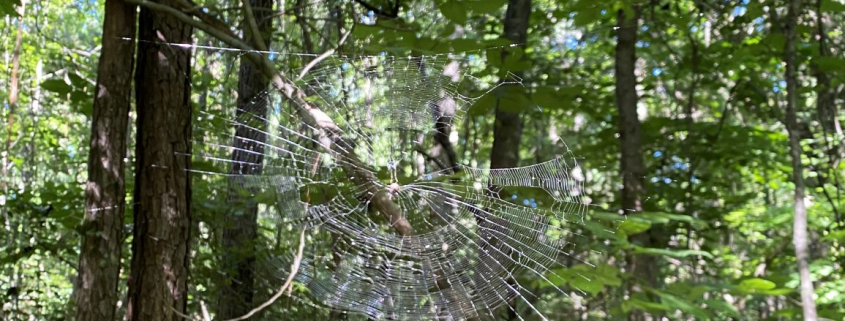A Forest Book of Mysteries, Surprises, and Revelations
Every forest…nay, each stand in every forest…contains rich stories of ecosystem life and living. Plants, animals, fungi, microorganisms, water, sunlight, soils…all dancing in evershifting patterns, choreographed by 3.8 billion years of evolution. The book’s type is not set, its stories and characters change minute by minute, hour by hour, day by day, year, decade, century, millenia, and deeper into time. The Wheeler National Wildlife Refuge riparian forest welcomed a human, one woefully ignorant of most intricate facets of the Nature of this forest and its long-held secrets, yet he brimmed with curiosity the afternoon of June 18, 2022.
The gravel access road served the visitor well, leading him to parking near the canoe launch on the southwest side of Blackwell swamp. He had previously biked many miles of the Refuge’s gravel roads. Since his November 2021 shoulder replacement surgery, the rough gravel has dissuaded him from other than hiking and bushwhacking.
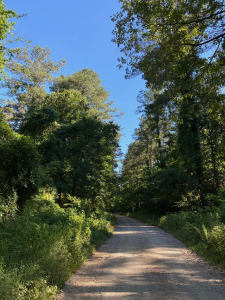
The Swamp
Blackwell Swamp always presents a pleasant face. This 3:07 PM view to the ESE across at least a quarter-mile of open (and vegetation-clogged) water takes advantage of the clear early summer air and mid-afternoon sun.
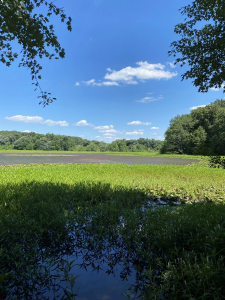
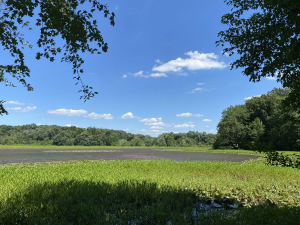
Never disappointed by this southern swamp just a quarter mile from the Tennessee River, fifteen miles from his Madison, Alabama home, the visitor visually consumed the aquatic vegetation, cerulean sky with cumulus puffs, abundant bird life, and swamp-edge forest. He recognized some plant species, understood the broad dynamics of the swamp, yet saw, too, so much complexity and life that he did not fully comprehend. You would think that after living as a passionate student of Nature for more than seven decades, he might know more. But alas, he has learned that the more he learns, the less he knows. Knowledge of natural systems, or for that matter, of almost anything, reminds the visitor of climbing a mountain. The broader the viewscape, the greater the mystery and secrets within the exponentially larger acreage. The more he sees, the less he knows.
The important thing is not to stop questioning. Curiosity has its own reason for existing. One cannot help but be in awe when he contemplates the mysteries of eternity, of life, of the marvelous structure of reality. It is enough if one tries merely to comprehend a little of this mystery every day. Never lose a holy curiosity. (Albert Einstein)
The Forest
Entering the forest, he immediately felt the air temperature drop ten degrees, but the heat-relieving breeze swampside stayed topside in the canopy 90-100 feet above the forest floor. Hungry mosquitoes buzzed and whined, attempting to penetrate the netting covering his face and neck. The forest canopy captured most sunlight, permitting only flecks and dapples to touch the forest floor.
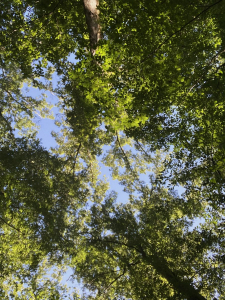
The visitor bushwhacked through a mixed pine/hardwood stand that yielded to pure hardwood-stocked lowground punctuated by higher well-drained ridges. Don’t jump to conclusions…the ridges stand just 3-7 feet above the lowground that during winter is often covered by shallow surface water. To the unacquainted the forest, just 70-90 years old, could be mistaken as old growth, taking on characteristics indicative of such:
An old-growth forest – also termed primary forest, virgin forest, late seral forest, primeval forest or first-growth forest – is a forest that has attained great age without significant disturbance and thereby exhibits unique ecological features and might be classified as a climax community. (Wikipedia)
Old growth characteristics include: large trees; multiple canopy layers; both seral (successional) and climax species; large standing snags; abundant dead and down woody debris; pockets of younger trees. This stand qualified. However, as the visitor rambled he found old drainage ditches dug decades earlier, when much of this forestland produced agricultural crops. He’s observed often that nothing in Nature is static. Some would have estimated that this large oak (below) stood for centuries. Not so. The visitor knew enough about forest development and Refuge history to surmise that many of these rich riverine sites had been farmed prior to TVA acquisition and that natural forest regeneration progresses rapidly, and that impressive forests emerge after just 70-90 years. He also observed that old growth stand characteristics can develop over periods of less that a century.
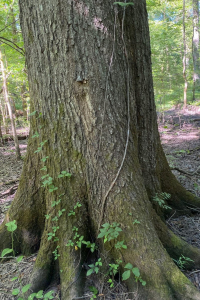
Life (and death) trace a story across the forest. The fallen (away from the camera) decaying tree (now a log) when alive stood at the boundary between where the lenticular, straw-hued mound stands elevated (perhaps a foot vertical) above the gray-white depression in the immediate foreground. A strong wind toppled the tree a decade or longer ago, lifting its soil-packed root ball, which with the roots decayed constitutes the mound. The depression, where the root ball lifted, is water-filled through the soil-saturated winter months, bleaching surface organic matter.
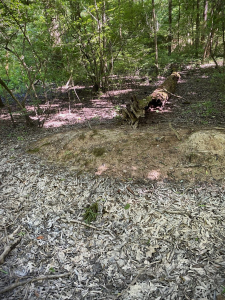
This two-foot diameter oak tells its own story. Picture the original seedling/sapling as a twin. Perhaps a deer or rabbit nipped the very young sprout, resulting in two sprouts competing in their reach skyward, creating a forked trunk. When the near-stem (probably both) had grown to a diameter the size of the opening, a natural force (wind, ice, a nearby falling tree) shattered the union, permitting decay fungi to infect the raw exposed wood. The fallen fork has long since returned to the soil. The visitor saw no trace of it. Although the still-living tree has fought valiantly to callous over the opening, alas the fungus has prevailed. The tree will forevermore remain hollow. Eventually, the laws of Nature and physics will bring the surviving fork to the ground, but not before it has produced decade after decade of acorns. The oak, when all is said and done, will have done its duty, doing everything in its power to have survived the test of time, and produced seed to assure its succession.
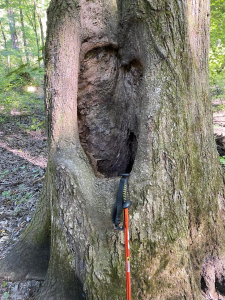
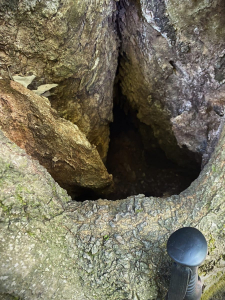
Fungi
The visitor, conscious of the role of fungi in the hollow oak tale, has learned to appreciate (and learn more about) the fungi kingdom of life. Rather than present a detailed narrative of the mushrooms he encountered, here is a brief recap. The peppery white milkcap appeared just once in his two-hour journey. Interestingly, this species is edible, a bit too peppery for most foragers (one reference referred to its taste as suddenly and intensely spicy or peppery). Our visitor photographed and cataloged the find, appreciating its place and sublime beauty. Below right see its fine dense gills.
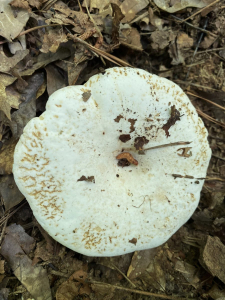
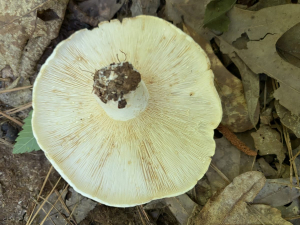
Its base is thick and meaty. It forms mycorrhizal associations with trees, therefore, this species appears on the soil surface, not on woody substrate.
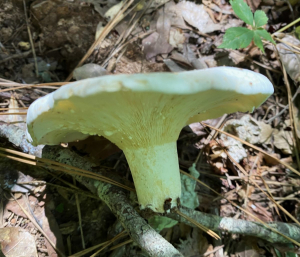
Another common early summer mushroom, Russula flavida is known as yellow russula. Like the peppery white milkcap, it forms mycorrhizal associations with trees, especially oaks.
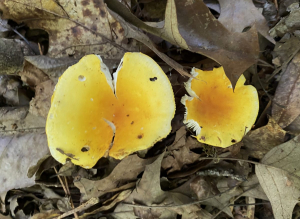
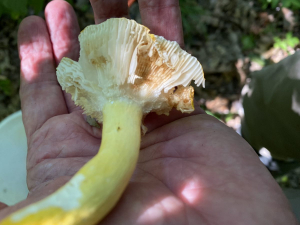
This artist bracket mushroom, a wood decaying species, graced a cavity at the base of a living oak. The distinct color and varnished appearance caught the visitor’s attention.
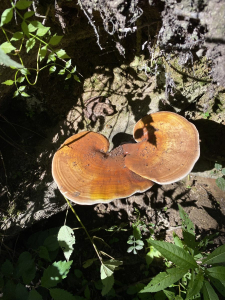
Leaning closer to photograph the shelf mushroom, he noticed its southern leopard frog companion. So much in Nature lies hidden in plain sight.
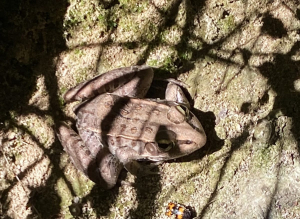
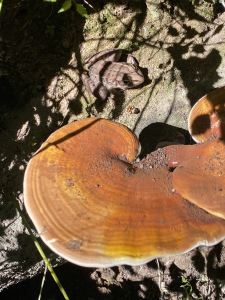
The visitor found his first chanterelle mushrooms of the young summer season. Smooth chanterelles dotted the forest floor on the gentle slide slopes separating the upland forest from the still-saturated bottoms. Recall that the upland forest lies only 3-7 vertical feet above the bottoms. This mycorrhizal fungi is particularly common in the Southeast and widely distributed in eastern North America (Mushrooms of the Southeast).
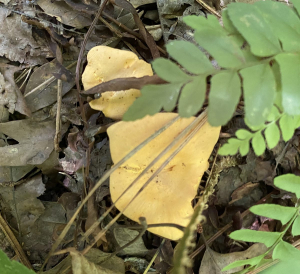
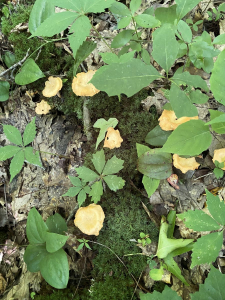
The chanterelle (various species here in northern Alabama) foraging season extends from mid-June through September. An ample helping of sauteed chanterelles (complemented with sliced onions) rewarded the visitor that evening!
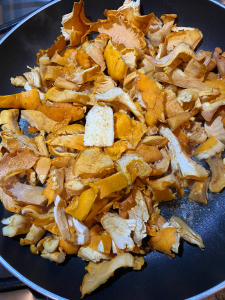
How grand that fungi 50 years ago merited their own kingdom. Their forms and functions are diverse, from the superbly edible chanterelles to the delightfully colorful yellow russula…from the tree-partner mycorrhizae to the decaying Ganoderma.
Flowers and Plants
The visitor encountered a flowering forest floor plant he did not recognize, genus Hylodesmum, a ticktrefoil. Leaves compound with three leaflets, its flower stock would not have drawn his attention had he not straddled it in passing. Upon reference checking for identification, he found that the plant’s seeds are little green packages when ripe, covered with adhesive bristles that cling to most any clothing brushing against them. The visitor nodded recognition of the seeds as beggar’s lice, displaying an ingenious method of seed dispersal, clinging tenaciously to animal fur (or human clothing), traveling along with its animal-uber until wear and friction release the passenger, with good fortune, at a suitable spot for gemination.
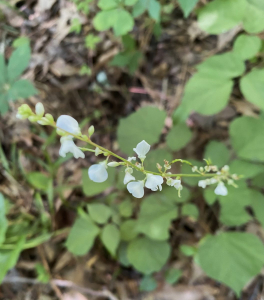
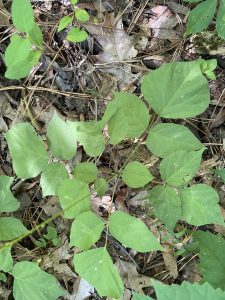
The black-eyed Susan has no secret hitchhiking intentions. It’s sole attractive purpose is to draw pollinators to taste its nectar, and in the act spread a bit of pollen among other flowers of its kind. In time, birds and other critter disperse its seeds.
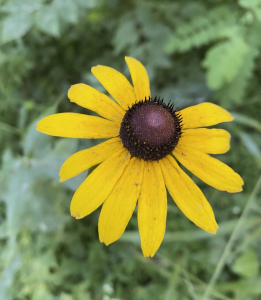
The missouri Botanical Gardens offers a hard-to-top description of a parasitic flowering plant the visitor identified along the access road as he returned to his vehicle:
Dodder is an annual seed-bearing parasitic vine in the dodder family (formerly placed in the morning-glory family). Its thin, thread-like, yellow or orange stems grow rapidly entwining and covering their host plants. Cuscate is the most common genus and is found throughout the US and Canada. Of the 50 species that occur, most are found in tropical and warm-temperate areas but some species also occur in cooler areas including St. Louis where they can grow from seed each year and infest herbaceous and small woody plants. Since seeds can be difficult to separate from some agricultural crops dodder has been spread widely through agriculture.
Dodder seeds germinate in soil and can live on their own for 5 to 10 days until they are about a foot tall. If they have not found a suitable host by this time the seedlings will die. Seedlings that find a suitable host twine around the plant and insert haustoria (modified adventitious roots) into the tender stem. The haustoria penetrate and tap the plant’s vascular system for water, minerals and nutrients. Plants are weakly photosynthetic, but most produce very little food on their own. They rely upon their host plant for survival. As the vine taps the host plant its connection to the soil is severed. Small, white, bell-shaped flowers form in late summer and early fall and can produce copious amounts of seed. Plants are annual and are killed by frost. Plants regrow from seed each year.
Harper’s dodder is native to northeastern Alabama. However, iNaturalist verified only that this is a dodder. A number of invasive dodders are naturalised to Alabama.
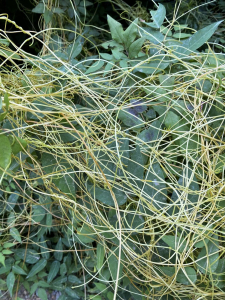
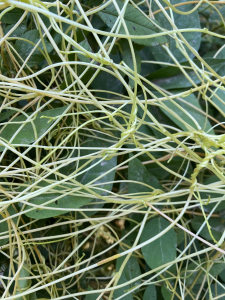
Other Critters
The visitor can attest that the riparian forest is home to all manner of insects and spiders. The aforementioned leopard frog is here for a reason. Insects are his primary caloric fortune. The frog performs his magic with a sticky elongated tongue. The orb weaver spider posted at the center of his solar-illuminated webbing likewise fuels his life on insect protein. The visitor, mosquito netting secured under his ball cap and draping over his his chest and shoulders, heard the constant whine of the Dipterian, blood-sucking hordes yearning for his blood.
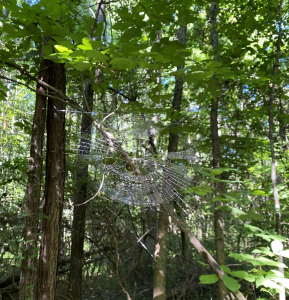
He characterized the mosquito-consuming arachnids as friends!
Leonardo da Vinci 500 years ago, perhaps as he considered a frog’s sticky tongue or the marvels of orb weaving spiders observed:
Human subtlety will never devise an invention more beautiful, more simple or more direct than does nature because in her inventions nothing is lacking, and nothing is superfluous.
Back to the Swamp and His Vehicle
Still regaining strength and conditioning from his November 2021, shoulder replacement and March 2022 stroke, the visitor felt the tiring exertion of two hours bushwhacking, foraging, briar-snagging, and occasional mucking in his rubber boots through standing water and brimful drainageways. He returned at 5:09 PM to once more capture Blackwell Swamp images, forest edge shadows now extending further into the swamp vegetation, the far-side forest vegetation super-illuminated by the lower angle sun rays.
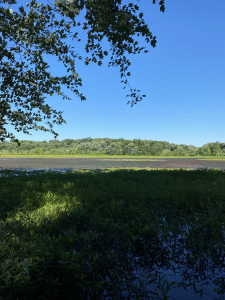
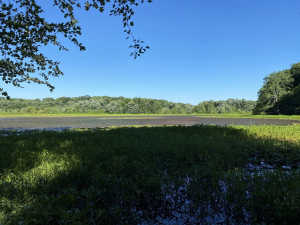
The visitor recalls his early career years practicing forestry, spending long days in the forest, performing inventory, assessing standing timber, laying out access roads, inspecting logging operations, supervising site preparation and tree planting, and doing prescribed burning. He speculates as he completes his first year following his 70th birthday how many hours, if at all, he could keep pace with his younger self. He knows that he would quickly frustrate that young man, serving more as anchor than companion. However, he relishes the quantum leap he has made in understanding and appreciating the marvels of the forest and the miracles revealed within. He can see more clearly and deeply, and with greater satisfaction and reward. His younger self had never met a wild edible chanterelle and would never have seen, much less been able to identify, the Ganoderma mushroom. He would have missed the leopard frog. He seldom saw what lay hidden in plain sight. Most amazingly, the younger man thought he already knew most everything he would ever need to know. And now, although the visitor knows far more now than he did then, he accepts that his knowledge and understanding are shallow and incomplete.
Yet, he knows enough to feel the power, glory, grace, and fulfillment that derive from his love affair with Nature. He is a student and practitioner of Nature-Inspired Life and Living. Too, he is learning more and more about Nature-Inspired Aging and Healing.
The young man would not have appreciated da Vinci’s wisdom in this simple observation:
Nature is so delightful and abundant in its variations that among trees of the same kind there would not be found one which nearly resembles another, and not only the plants as a whole, but among their branches, leaves, and fruit, will not be found one which is precisely like another.
Life is Good!
Thoughts and Reflections
I offer these observations:
- Wild places reveal new secrets every time we visit; their mysteries lie hidden in plain sight.
- The important thing is not to stop questioning. Curiosity has its own reason for existing. (Einstein)
- Walking in the forest rewards far more than walking through the forest. Wander patiently…and with purpose!
Inhale and absorb Nature’s elixir. May Nature Inspire, Inform, and Reward you!
Note: All blog post images created & photographed by Stephen B. Jones unless otherwise noted. Please circulate images with photo credit: “©2022 Steve Jones, Great Blue Heron LLC. All Rights Reserved.”
Another Note: If you came to this post via a Facebook posting or by an another route, please sign up now (no cost… no obligation) to receive my Blog Post email alerts: http://eepurl.com/cKLJdL
And a Third: I am available for Nature-Inspired Speaking, Writing, and Consulting — contact me at steve.jones.0524@gmail.com
Reminder of my Personal and Professional Purpose, Passion, and Cause
If only more of us viewed our precious environment through the filters I employ. If only my mission and vision could be multiplied untold orders of magnitude:
Mission: Employ writing and speaking to educate, inspire, and enable readers and listeners to understand, appreciate, and enjoy Nature… and accept and practice Earth Stewardship.
Vision:
- People of all ages will pay greater attention to and engage more regularly with Nature… and will accept and practice informed and responsible Earth Stewardship.
- They will see their relationship to our natural world with new eyes… and will understand more clearly their Earth home.
Tagline/Motto: Steve (Great Blue Heron) encourages and seeks a better tomorrow through Nature-Inspired Living!
Steve’s Three Books
I wrote my books Nature Based Leadership (2016), Nature-Inspired Learning and Leading (2017), and Weaned Seals and Snowy Summits: Stories of Passion for Place and Everyday Nature (2019; co-authored with Dr. Jennifer Wilhoit) to encourage all citizens to recognize and appreciate that every lesson for living, learning, serving, and leading is either written indelibly in or is powerfully inspired by Nature.
I began writing books and Posts for several reasons:
- I love hiking and exploring in Nature
- I see images I want to (and do) capture with my trusty iPhone camera
- I enjoy explaining those images — an educator at heart
- I don’t play golf!
- I actually do love writing — it’s the hobby I never needed when my career consumed me
- Judy suggested my writing is in large measure my legacy to our two kids, our five grand kids, and all the unborn generations beyond
- And finally, perhaps my books and Blogs could reach beyond family and touch a few other lives… sow some seeds for the future


All three of my books (Nature Based Leadership; Nature-Inspired Learning and Leading; Weaned Seals and Snowy Summits) present compilations of personal experiences expressing my (and co-author Dr. Wilhoit for Weaned Seals and Snowy Summits) deep passion for Nature. All three books offer observations and reflections on my relationship to the natural world… and the broader implications for society. Order any and all from your local indie bookstore, or find them on IndieBound or other online sources such as Amazon and LifeRich.

